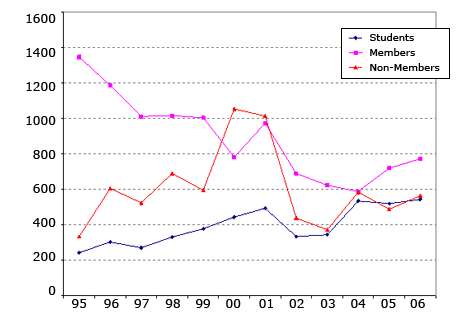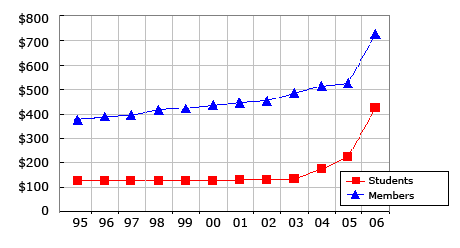CHI 2006 Registration Statistics
Message from Dennis Wixon, SIGCHI VP for Conferences
On behalf of the CMC and CHI 2007, I’d take this opportunity to discuss the following:
- CHI 2006 attendance
- The distribution of conference expenses
- Student fees and some historical attendance trends
CHI 2006 attendance
CHI 2006 had the highest attendance in five years. Attendance in all categories increased by about 18% over 2005. While many factors affect attendance certainly one of the most important is the conference program, Gary and Robin put together a strong program with broad appeal All of the volunteers deserve our congratulations and thanks not only for their hard work but also for the pioneering innovations that they introduced.
Looking at the attendance figures in more detail here is the breakdown:
- Students: 29%
- Members: 41%
- Non-Members: 30%
Focusing on student attendance in relation to income, students constitute 29% of attendance and provide about 15% of the income.
The graph below shows how attendance has fluctuated and how attendance mix has changed over the year.

Some general patterns emerge:
- Overall attendance began a rapid climb in 99 which continued to 2001. CHI 2002 saw substantial drop in attendance. External events which probably played are role included the dot com and telco collapse and the 9/11 tragedy. This trend was not reversed until 2004.
- Overall member attendance has been dropping; this trend was reversed in 2005 and 2006, but has not yet recovered to 2001 level.
- The number of non-members attending increases when CHI occurs in Europe (2000 and 2004) and there is a corresponding drop in member attendance.
- Non member attendance is quite volatile, reflecting business cycles.
- The changes in other attendance categories mean that over 11 years we have had a steady increase in the proportion of students attending.
- Finally one might wonder why member attendance has shown such a steady decline. There are a couple of hypotheses. 1) CHI has spawned a number of sister conferences which could be drawing attendance from CHI (they also may increase the total number of attendees), 2) as the field matures members begin to send their students rather than go themselves. To the extent this is true it represents a healthy and maturing field.
The graph below shows long term trends in fee structure for members and students.

At least one way to look at student fees is they were kept low for a number of years despite an increasing proportion of student attendees. Even with the increase in student fees in 2006, the number of students attending did not drop and contribution to the overall conference revenue by students is still below their attendance proportion.
However, looking at the fees alone is only part of the story. Significant changes to the conference included an increase in the number of days and the integration of tutorials/courses into the conference. These changes can also be put in context.
- In general, about 90% of survey respondents each year report that CHI was worth the time and money. This number has been relatively stable even in 2006 with a longer and more expensive conference.
- Results from direct question about the increase in conference length show almost twice as many attendees see this as a positive change in comparison to those who see it as a negative change.
- Course attendance was dramatically up this year with about 80% of the course seats filled. In addition about 30% of the course attendees were students. This is a significant change from historical trends in which tutorial attendance was dropping along with income. In addition the old model effectively priced students out.
- We can always assume that feedback on the reduction in course fees would be positive.
- Feedback on including courses in the overall program was mixed.
- Finally the courses like the rest of the program constitute a 3 year experiment so that we can fully assess their impact. The pronounced success of CHI 2006 in terms of attendance and financial results is not sufficient to enshrine the current model over the long term.
Given the concerns of the community about the student fee increases for CHI 2006, we are continuing to investigate ways to ease the financial burden on students and their advisors. For example, we increased the number of student volunteers and will investigate options for housing support as was provided for SVs in 2006. We plan to help in roommate finding for students seeking to share costs. Finally, we will offer a $50 registration discount for student members of SIGCHI.
How does the CHI conference manage its income and expenses?
The expenses to put on a conference like CHI fall into several categories. However we must recognize an expense that is much larger than any other but is hidden. That is the value of the time donated by volunteers at all levels. If the donated time were an actual expense it would run well into the millions and dwarf any other expense category. Everyone contributes, but the contribution of conference chairs and each area chair (e.g. papers) need to be particularly noted. They not only create the conference but also they are responsible for recruiting the literally thousands of volunteers who perform all the necessary work. CHI is truly a volunteer conference and it is what the volunteers make it.
In terms of the financial budget for CHI it breaks down as follows (I have consolidated expenses into broad categories):
| Publications (including conference final program signage ) | 10% |
| Committee (meetings, supplies which lead up to the conference) | 16% |
| Operations (AV, conference management, facilities rental) | 40% |
| Food & Beverage (including breaks and recognition events) | 26% |
| All Other | 8% |
In addition to these expenses, the conference has the following obligations which it must meet before it can be considered to have “broken even”.
- An ACM allocation – which represents the “insurance” ACM provides the conference in case they cannot meet their expenses.
- A SIGCHI return – which contributes to the SIGCHI fund balance. The fund balance is a second line of insurance for all conferences and the society itself. Despite the financial success of CHI 2005 and 2006 we have not fully recovered losses of CHI 2002 and 2003. It’s also important to note that some conference venues are more expensive that others. Conferences in Europe generally cost and constitute a greater risk and carrying a larger fund balance before a European conference is prudent. (It’s important to note that CHI 2000 returned significant money to SIGCHI and CHI 2004 broke even.)
When conference revenues fall short of projections all these items are considered for cuts. Conversely, when revenues meet or exceed expectations, additional income is “returned” to attendees and volunteers in terms of better food for all the attendees, small committee appreciation gifts, and enhancements to the student volunteer party. The rest is returned to SIGCHI.
Overall the increase in attendance combined with the positive feedback suggests that conference reforms are effective. We are making some changes to address the concerns raised by attendees, particularly in the areas of student fees.
Finally one point that always requires emphasis. SIGCHI and every CHI conference is the product of volunteer effort. The most effective way to have an influence is get involved. In that spirit I want to thank again the volunteers who worked so hard to make CHI 2006 a success and encourage everyone to participate in CHI 2007 by volunteering, submitting and attending.

